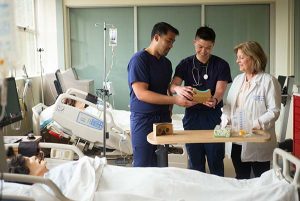
Photo: James Tensuan
From left, Jeland Palicte, Bryan Dang and Professor Colleen O’Leary-Kelley, explore virtual reality as a teaching tool for nursing simulations. The students competed at the CSU Student Research Competition in April, along with eight other Spartans.
By David Goll
On April 28 and 29, 10 Spartans represented San Jose State University at the 31st Annual California State University Student Research Competition at Cal Poly San Luis Obispo. Of the eight projects presented, two students received second place honors: Ryan T. Scott, who competed in the graduate-level category of biological and agricultural sciences and Mary Ryan, who competed in the graduate-level category of humanities and letters.
Scott worked on his project with his faculty mentor Peggy Plato, a kinesiology professor in the College of Applied Sciences and Arts. He studied how zoledronate, a drug given to prevent bone loss, prevents simulated weightlessness-induced bone loss while blunting the efficacy of a mechanical loading countermeasure. Ryan worked on her project with faculty mentor Daniel Silverman, an associate professor of linguistics and language, in the College of Humanities and the Arts. She compared data of Western Andalusian and Castilian Spanish speakers to explain lenition in the language, a type of sound change that alters consonants to make them sound more vowel like. The winners from all 23 CSU campuses are recognized online.
The students who competed at the CSU level first participated in SJSU’s Research Competition on March 1 and 2. They were recognized along with other students involved in a diverse cross section of research, scholarship and creative activities (RSCA) at SJSU’s 38th Annual Student Research Forum on April 5. The event showcased the wide variety of RSCA in which students are engaged. Some are searching for solutions to streamline and lower the cost of training health care workers while others are working to combine artistic andacademic passions by transforming an elaborate art form from 17th-century France to come alive in modern times.
“I was ecstatic when I heard I was among the (SJSU) finalists,” said Sarah Lysgaard, a graduate student in art history, at the forum on April 5. “Honestly, I couldn’t believe it. Public speaking has not been one of my strong points.”
Lysgaard’s three-year project, titled “Ballet de la Nuit: Staging the Absolute Monarchy of Louis XIV,” highlights one of the extravagant, 12-hour theatrical spectacles incorporating music, dance and poetry of centuries ago.
“I researched the meaning of these productions in the 17th century, but also how they still have an impact on our arts today, and the world in general,” Lysgaard said. “They set the ground rules and structures for fashion, the arts and government still in use today.”
Gilles Muller, SJSU’s associate dean of research, oversees the SJSU competition. Each of the seven colleges can select up to four individual or team projects to compete. This year, entries came from five colleges: the College of Applied Sciences and Arts, Charles W. Davidson College of Engineering, the College of Humanities and the Arts, the College of Science and the College of Social Sciences.
Viewing of the research competition was open to faculty, friends and relatives of student researchers, along with the judges. Muller hopes to expand access to attend the competition more broadly next year.
“We want our student research to be a celebration of their work,” said Muller, who arrived as a professor in the SJSU Department of Chemistry in 2004. “And we want a broad and diverse range of research projects.”
Another student research project has great commercial potential, according to Colleen O’Leary-Kelley, SJSU professor of nursing and Clinical Simulation coordinator for the School of Nursing. She served as the faculty mentor for two December graduates, Bryan Dang and Jeland Palicte, whose project was titled, “Virtual Reality in Simulation Training: a Comparative Study for Heightening Learning Immersion to Increase University Bandwidth.”
Still students at the time, Dang and Palicte plunged into the project, theorizing virtual reality cameras could provide a cheaper way to provide training for student nurses. Most schools today rely on high-fidelity patient simulation, or computerized manikins that simulate human patients. Training occurs not only for the students tending to the manikin, but for those offsite who can observe through television cameras.
“They can birth babies, wet the bed, do almost everything a human can do,” Dang said. “Except jump out of bed.”
However, the manikins are also expensive, ranging in price from $30,000 to $120,000 each, Dang said.
Dang and Palicte’s project revealed some improvement in training when virtual reality cameras are used at bedside instead of a TV. It allows “an unlimited number of students to be able to observe in real time, kind of like having Google Earth,” he said.
Further research will be necessary to establish VR’s superiority as a training tool.